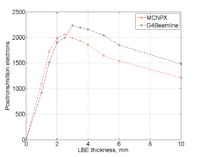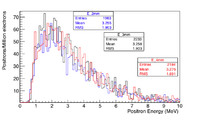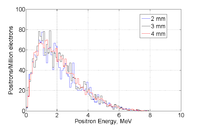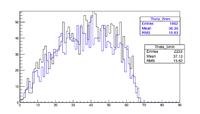G4Beamline PbBi
Development of a Positron source using a PbBi converter and a Solenoid
Converter target properties
Definition of Lead Bismuth
1cm diameter target
2 mm thick PbBi
0.5 Tesla solenoid
G4BeamLine and MCNPX
Target thickness optimization
First simple test is to send 1 million, 10 MeV electrons towards a PbBi target and count how many positrons leave the downstream side
The Random number seed is set by Time in G4beamline to use a different set of pseudo random numbers each time it is run
The G4Beamlin incident electron beam has the following properties
beam gaussian particle=e- nEvents=1000000 beamZ=0.0
sigmaX=1.0 sigmaY=1.0 sigmaXp=0.100 sigmaYp=0.100
meanMomentum=10.0 sigmaP=4.0 meanT=0.0 sigmaT=0.0
| PbBi Thickness (mm) | #positrons/million electrons (G4Beamline) | #positrons/million electrons (MCNPX) |
| 1 | 960,874, 916,934,897=916 +/- 33 | 1091 |
| 1.5 | 1508 | 1728 |
| 2 | 1963,1919,1880,1877,1970 = 1902 43 | 1984 |
| 2.5 | 1997 | 2062 |
| 3 | 2233,2250, 2251,2226 , 2222=2236 13 | 1986 |
| 3.5 | 2193 | 1938 |
| 4 | 2184,2156,2089,2173,2181=2157 39 | 1858 |
| 5 | 2042 | 1646 |
| 6 | 1851, 1932, 1857, 1896 | 1541 |
| 10 | 1480 | 1216 |
Comparison of G4Beamline and MCNPX
Energy Distribution
Angular distribution of positrons
2mm thick, 10 MeV, 1 cm cylindrical incident electron distribution, 100k positrons, 1 million electrons, commas eliminated, on surface of target find x,y,z,Px,Py,Pz for positrons and electrons



